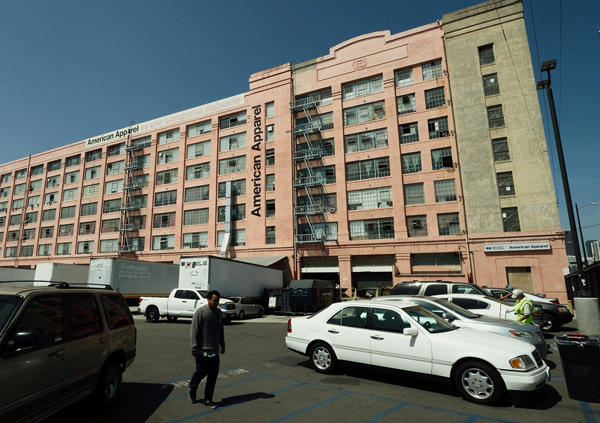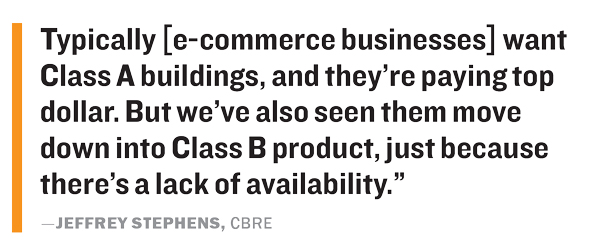Trending
Retail pain is industrial’s gain

Every day in Los Angeles, countless packages are placed on Angelenos’ doorsteps. Inside, there’s a new pair of shoes, an emergency supply of diapers or that night’s dinner, ingredients portioned out for easy preparation. Each box, brimming with the promise of something new, is a skipped visit to a brick-and- mortar store.
Traditional sellers have paid the price. Dozens of retailers this year have announced thousands of store closures across the country, and they’re not only in the sort of mediocre malls that have long struggled. Flagship streets like Rodeo Drive and Manhattan’s Fifth Avenue are also seeing more vacancies.
Fashion design and manufacturing, one of L.A.’s more prominent local industries, has begun to buckle under the pressure to compete with online retailers. As a result, they’re vacating their backend warehouses, thereby making way for the very industry that undermined their business in the first place.
It’s all sad news for brick-and-mortar retail, but it’s great news for the inventory-starved industrial market, where property owners are out hustling to keep up with the pace of demand brought on by e-commerce.
American Apparel, once a shining example of local clothing manufacturing, closed all 110 of its U.S. stores this spring after filing for bankruptcy twice and selling its brand to Canadian firm Gildan Activewear. The company’s demise put at least four industrial buildings totaling more than 750,000 square feet back on the market, including its headquarters in Downtown Los Angeles and production facilities in South Gate and Garden Grove. In June, the company’s distribution center space in La Mirada was snapped up by Japanese home goods retailer Daiso Industries in a $12 million six-year lease agreement with landlord Prologis.
Meanwhile, BCBG Max Azria filed for bankruptcy this spring and announced it would close 120 U.S. stores (including Puerto Rico), including two on Rodeo Drive. In June, the company received a $165 million buyout from a consortium lead by Marquee Brands, which owns Ben Sherman and Bruno Magli, and Global Brands Group Holding, which owns Jones New York and Juicy Couture. As the deal is set to close at the end of July, the fate of BCBG’s trio of warehouses in Vernon, totaling more than 600,000 square feet, remains in limbo.
And Delta Galil, the new Israeli owner of L.A. fashion brands 7 For All Mankind, Splendid and Ella Moss, has been tightening operations by cutting brand staff and consolidating headquarters. To that end, in May, the firm sold the 7 For All Mankind headquarters to Irvine-based investment firm LBA Realty. The 220,000-square-foot property, which included a rare Class A office component, sold for about $29 million, or $132 per square foot, according to Real Capital Analytics.

Joe Dimola of JLL, who along with Paul Sablock represented both buyer and seller in the sale, said that LBA Realty plans to upgrade the industrial space to a true warehouse distribution use. The clothing brand, which shared the space with a commercial laundry tenant, used the facility to dye denim. Once renovated, the building will likely be a big draw for e-commerce and support companies such as those in the third-party logistics industry.
“We’re probably going to find a user in the warehouse and distribution industry,” said Dimola, who will continue to represent LBA Realty in future lease negotiations. “A retail or e-commerce company is definitely the favorable tenant because they don’t put a lot of wear and tear on the building.”
Analysts have predicted that another clothing company, True Religion Brand Jeans, which moved its headquarters from Vernon to Manhattan Beach last year, could soon go the way of American Apparel, freeing up even more potential industrial space. In late January, the public company was reported to be near defaulting on its roughly $485 million in debt.
Andrew Briner, a managing director for commercial real estate firm Holliday Fenoglio Fowler (HFF), said consumer demand for convenience is driving the industrial market like never before.
“E-commerce has revolutionized the industrial business,” he said. “Consumers now want things faster, not slower. I was perfectly happy when I could order something online and get it three days later, but kids in their 20s now want things the same day.”
Thanks to the warehousing and distribution needs of online retailers, nationwide vacancy rates for industrial properties are at a 17-year low, and rents are at record highs, according to a recent report by JLL.
California boasts the three tightest industrial markets in the country, with Los Angeles at the top with less than 1 percent (0.9) vacancy (San Francisco’s East Bay and Orange County were the runners-up). Average L.A. asking rents, meanwhile, are sky-high at $9.12 per square foot annually.
Over the last two years, e-commerce has overcome traditional brick-and-mortar retailers as the single most active sector in the industrial real estate market, ahead of traditional retail and consumer nondurables. In recent months, e-commerce has only continued to gain market share, according to JLL.
Jeffrey Stephens, a senior vice president for CBRE, said the rise of e-commerce has resulted in a massive expansion of third-party logistics companies, which are willing to pay a premium to get a foot in the door.
“A lot of these companies are less price sensitive to exactly what their rent will be, but they need function,” he said. “Typically they want Class A buildings, and they’re paying top dollar. But we’ve also seen them move down into Class B product, just because there’s a lack of availability … A lot of times they’re just taking the first deal they can find because there’s nothing else out there.”
Mike McCrary of JLL, said that traditional retailers generally failed to recognize and act on the shift in the retail industry. Now, he said, it’s a whole different ball game.
“Everybody keeps using the word ‘e-commerce,’ but the reality is that it’s now just retail. We’ve moved past where there was a difference,” he said. “If you’re a retailer and you’re selling goods, you’d better have some sort of e-commerce capacity or strategy, otherwise you’re gone.”




